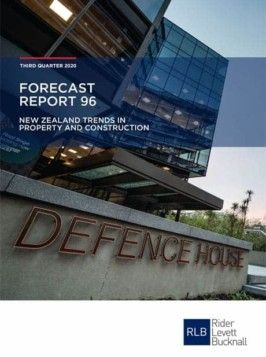According to the Rider Levett Bucknall (RLB) Forecast 96 report – New Zealand Trends in Property and Construction – residential accommodation demand has fallen, impacted by the fall in net migration as a consequence of COVID-19.
Prepared by the New Zealand Institute of Economic Research (Inc.) (NZIER) exclusively for RLB, Forecast 96 found that COVID-19 continues to be a major influence on New Zealand and international economies.
RLB Director Grant Watkins said, ‘Net migration, which had previously been a key driver of population growth and hence residential accommodation demand, has virtually stopped.’
‘In the six months to September, net migration of all citizenships was 2,500, compared with an average of over 20,000 in the same period in recent years,’ he added.
Confidence picks up due to stimulus measures
According to RLB, there are nonetheless signs that confidence and demand in New Zealand is picking up, as the economy responds to the unprecedented amount of stimulus measures implemented by the government and the Reserve Bank. These measures include the wage subsidy scheme, lower interest rates, and increased government spending on infrastructure. The rebound in activity suggests a V-shaped recovery for the New Zealand economy.
Employment increases in construction, but falls in accommodation and hospitality
The increased government spending on infrastructure is underpinning the strong rebound in construction demand. This rebound is flowing through to increased demand for workers in the construction sector, with the September quarter labour market data release showing increased employment in the construction, healthcare and education sectors.
This increase was in stark contrast to the decline in employment in the accommodation and hospitality, and administration services. These shifts in employment demand highlight the uneven nature of the effects of the COVID-19 outbreak across the sectors of the New Zealand economy.
Impact of COVID-19 on economy uneven
The trends over the past year reflect the uneven impact of the COVID-19 outbreak on the economy. Border restrictions have had a particularly negative impact on sectors exposed to tourism such as accommodation and retail, and this is flowing through to construction demand in these sectors.
Grant continued, ‘With the growing popularity of online shopping, particularly with the enforcement of lockdown and social distancing restrictions, there has been a reduced demand for bricks and mortar shops over the longer term.’
Online shopping increases need for storage facilities
This shift towards online shopping has increased demand for storage facilities over the past year. It is expected that online shopping will drive a continued shift in construction demand from retail outlets towards storage facilities over the coming years.
‘A move to working from home for at least some days of the week for many office workers may also shift the geographic distribution of retail outlets from the inner city to the outer suburbs,’ he added.
Healthcare sector remains robust
RLB also found that the demand for healthcare facilities has also increased, reflecting the shift towards healthcare during the pandemic. The ageing population also means that demand for healthcare facilities should remain robust over the longer term.
Meanwhile, demand for office space declined as workers in professional services adapted to working from home in the wake of the lockdown restrictions under Alert Levels 3 and 4.
Auckland construction demand weak for retail, social and office space
Grant noted, ‘Although non-residential consent issuance in Auckland picked up strongly in recent months, it has yet to make up for the sharp decline over the first half of 2020. Weaker non-residential construction demand in the region over the past year was spread across retail outlets, social buildings and office space.’
‘However, there was a surge in Auckland office consent issuance in September. The increase in vacancy rates across both prime and secondary-grade office space points to reduced demand for Auckland office building construction over the coming years,’ he said.
RLB expects non-residential construction demand in the other Auckland sectors will pick up over the coming years in line with the recovery in activity more broadly.
Wellington office vacancy rates remain low
In Wellington, non-residential consent issuance has been particularly strong over the past year. This growth was driven by stronger demand for the construction of office (particularly in June), storage and social buildings. The dominance of the public sector in Wellington means that vacancy rates for office space remains low relative to the other regions, which should underpin continued demand for office construction.
Canterbury sees sharp decline in non-residential construction
In contrast, non-residential construction demand in Canterbury continued to fall sharply over the past year, reflecting broad-based weakness across the sectors. There was a particularly large decline in demand for the construction of education and social buildings.
RLB expects the effects of the COVID-19 outbreak to weigh on Canterbury non-residential construction demand over the next year, particularly in areas exposed to tourism.
FURTHER INFORMATION:



